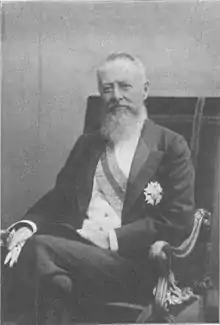Francis Richard Plunkett
Sir Francis Richard Plunkett GCB GCMG PC (3 February 1835 – 28 February 1907) was an Anglo-Irish diplomat.[1][2]

Early life
Plunkett was born at Corbalton Hall in County Meath, Ireland. He was the youngest son of Arthur Plunkett, 9th Earl of Fingall and Louisa Emilia Corbally, daughter of Elias Corbally of Corbalton. He was educated at St Mary's College, Oscott.[2]
Family
He married Mary Tevis Morgan, daughter of Charles Wain Morgan of Philadelphia and his wife Heloise Tevis, in 1870. She died in 1924. They had two daughters, Norah and Helen. Norah married the Swedish diplomat Count August Gyldenstolpe, Swedish Envoy to France 1905-1918. Helen never married.
Career
Plunkett entered the diplomatic service in 1855.[2] In 1873, he was nominated as Secretary of Legation in Tokyo under Sir Harry Parkes.[3] He left Tokyo in 1876 and served as Diplomatic Secretary in St Petersburg, Constantinople and Paris before being appointed Parkes's successor in Japan. He was noted for kindness and affability, which made him a great success in each of his diplomatic missions.
Plunkett was the British Minister in Tokyo, 1884–87,[4] He was made a Knight Commander of the Order of St Michael and St George while in Tokyo.
In 1900 he was appointed Ambassador at Vienna. The following year he was appointed to the Privy Council in February 1901,[5] and was created a Knight Grand Cross of the Order of the Bath (GCB) on 9 November 1901.[6]
He retired in 1905 and died of heart failure in Paris in 1907, after suffering from a bout of influenza.[2]
See also
- List of Ambassadors from the United Kingdom to Japan
- Anglo-Japanese relations
Notes
- Ian Nish. (2004). British Envoys in Japan 1859-1972, pp. 53-62.
- "Death of Sir Francis Plunkett". The Times. The Times Digital Archive. 1 March 1907. p. 10.
- Addison, Henry Robert. (1901). Who's Who Vol. 53, p. 901, p. 901, at Google Books
- The first British Ambassador to Japan was appointed in 1905. Before 1905, the senior British diplomat had different titles: (a) Consul-General and Envoy Extraordinary and Minister Plenipotentiary, which is a rank just below Ambassador.
- "No. 27283". The London Gazette. 12 February 1901. p. 1057.
- "No. 27376". The London Gazette. 12 November 1901. p. 7291.
References
- Ian Nish. (2004). British Envoys in Japan 1859-1972. Folkestone, Kent: Global Oriental. ISBN 9781901903515; OCLC 249167170
External links
- UK in Japan, Chronology of Heads of Mission